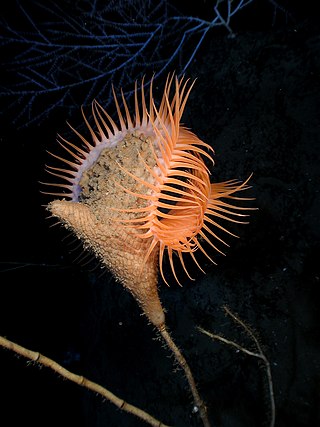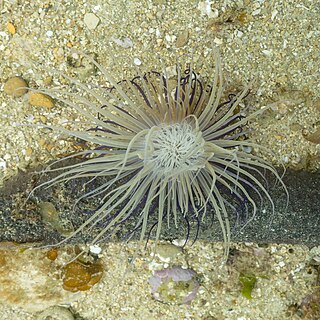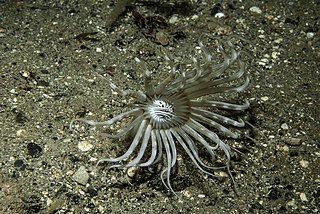
Cnidaria is a phylum under kingdom Animalia containing over 11,000 species of aquatic animals found both in freshwater and marine environments, predominantly the latter.

Anthozoa is a class of marine invertebrates which includes the sea anemones, stony corals and soft corals. Adult anthozoans are almost all attached to the seabed, while their larvae can disperse as part of the plankton. The basic unit of the adult is the polyp; this consists of a cylindrical column topped by a disc with a central mouth surrounded by tentacles. Sea anemones are mostly solitary, but the majority of corals are colonial, being formed by the budding of new polyps from an original, founding individual. Colonies are strengthened by calcium carbonate and other materials and take various massive, plate-like, bushy or leafy forms.

In zoology, a tentacle is a flexible, mobile, and elongated organ present in some species of animals, most of them invertebrates. In animal anatomy, tentacles usually occur in one or more pairs. Anatomically, the tentacles of animals work mainly like muscular hydrostats. Most forms of tentacles are used for grasping and feeding. Many are sensory organs, variously receptive to touch, vision, or to the smell or taste of particular foods or threats. Examples of such tentacles are the eyestalks of various kinds of snails. Some kinds of tentacles have both sensory and manipulatory functions.

Tube-dwelling anemones or ceriantharians look very similar to sea anemones but belong to an entirely different class of anthozoans. They are solitary, living buried in soft sediments. Tube anemones live inside and can withdraw into tubes, which are composed of a fibrous material made from secreted mucus and threads of nematocyst-like organelles known as ptychocysts. Within the tubes of these ceriantharians, more than one polyp is present, which is an exceptional trait because species that create tube systems usually contain only one polyp per tube. Ceriantharians were formerly classified in the taxon Ceriantipatharia along with the black corals but have since been moved to their own class, Ceriantharia.

The Venus flytrap sea anemone is a large sea anemone that superficially resembles a Venus flytrap. It closes its tentacles to capture prey or to protect itself. It is a deep ocean species.

Hexacorallia is a class of Anthozoa comprising approximately 4,300 species of aquatic organisms formed of polyps, generally with 6-fold symmetry. It includes all of the stony corals, most of which are colonial and reef-forming, as well as all sea anemones, and zoanthids, arranged within five extant orders. The hexacorallia are distinguished from another class of Anthozoa, Octocorallia, in having six or fewer axes of symmetry in their body structure; the tentacles are simple and unbranched and normally number more than eight. These organisms are formed of individual soft polyps which in some species live in colonies and can secrete a calcite skeleton. As with all Cnidarians, these organisms have a complex life cycle including a motile planktonic phase and a later characteristic sessile phase. Hexacorallia also include the significant extinct order of rugose corals.

Pachycerianthus fimbriatus is a cerianthid anemone that burrows in substrate and lives in a semi-rigid tube made of felted nematocysts. The anemone is often seen in bright orange to red.

Anemonia sulcata, or Mediterranean snakelocks sea anemone, is a species of sea anemone in the family Actiniidae from the Mediterranean Sea. Whether A. sulcata should be recognized as a synonym of A. viridis remains a matter of dispute.

Sea anemones are a group of predatory marine invertebrates of the order Actiniaria. Because of their colourful appearance, they are named after the Anemone, a terrestrial flowering plant. Sea anemones are classified in the phylum Cnidaria, class Anthozoa, subclass Hexacorallia. As cnidarians, sea anemones are related to corals, jellyfish, tube-dwelling anemones, and Hydra. Unlike jellyfish, sea anemones do not have a medusa stage in their life cycle.

Diadumene lineata, the orange-striped green sea anemone, has several morphotypes which have been described multiple times.

Cerianthus is a genus of tube-dwelling anemones in the family Cerianthidae. Members of the genus are found worldwide. They are predators, scavengers and omnivores.

The burrowing anemone is a species of tube-dwelling anemone in the family Cerianthidae.

Boloceroides daphneae is a cnidarian which occurs in the depths of the East Pacific Rise and was described in 2006.

Anthopleura ballii, commonly known as the red speckled anemone, is a species of sea anemone in the family Actiniidae. It is found in shallow water in the northeastern Atlantic Ocean.

Cerianthus membranaceus, the cylinder anemone or coloured tube anemone, is a species of large, tube-dwelling anemone in the family Cerianthidae. It is native to the Mediterranean Sea and adjoining parts of the northeastern Atlantic Ocean.

Ceriantheomorphe brasiliensis is a species of tube-dwelling anemones in the family Cerianthidae. It is found in the tropical western Atlantic Ocean, the Caribbean Sea and the Gulf of Mexico. It is currently listed as endangered based on a lack of evidence.

Arachnactidae is a family of tube-dwelling anemones in the order Ceriantharia. It is the only family in the monotypic order Penicillaria and comprises around 38 species. They differ from other ceriantharians in the makeup of their cnidome, the relative sizes of the oral discs and the shape and structure of the mesenteries. These tube anemones dwell in parchment-like tubes immersed in soft sediment, and have two whorls of tentacles, the outer ones being much longer than the inner ones.
Anthopleura stellula is a species of sea anemone in the family Actiniidae. It was first described in 1834 by Wilhelm Hemprich and Christian Gottfried Ehrenberg as Actinia (Isacmaea) stellula. It is found in the Indian Ocean and the Red Sea, and is unusual among sea anemones in that it can divide itself in two transversely.

Gonactinia is a monotypic genus of sea anemones, and G. prolifera is the only species in the genus. It is sometimes called the storey anemone and is found on either side of the northern Atlantic Ocean.

Bunodosoma cavernatum, commonly known as the warty sea anemone or the American warty anemone, is a species of sea anemone in the family Actiniidae. It occurs in the tropical and subtropical western Atlantic Ocean and the Caribbean Sea. It was first described in 1802 by the French naturalist Louis Augustin Guillaume Bosc, one of fourteen marine invertebrates described and named by him.




















